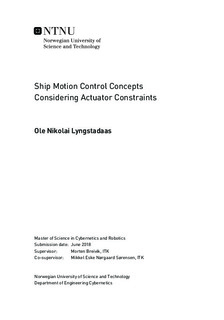Ship Motion Control Concepts Considering Actuator Constraints
Master thesis
Permanent lenke
http://hdl.handle.net/11250/2560385Utgivelsesdato
2018Metadata
Vis full innførselSamlinger
Sammendrag
Numerous motion controllers and autopilots have been proposed over the years. Most control algorithms found in the literature do not explicitly consider saturation constraints for the actuators. In traditional control theory, an ideal controller might achieve perfect reference tracking in simulations, having no or non-sufficient limitations on the control input. However, in real-life applications it would not be feasible due to limitations in physical output and wear and tear of the actuators.
This thesis presents mathematical modeling of a ship and actuator constraints, and the development and implementation of cascaded feedback controllers, including stability analysis and suggested tuning rules. In addition, a magnitude-rate saturation model is modified to fit ship motion control systems and used to handle actuator constraints. Furthermore, the use of a simplified dynamic window algorithm to handle actuator magnitude constraints for a 3 degrees of freedom dynamic positioning controller for ships, is developed. To accomplish this, a simplified version of the 2 degrees of freedom dynamic window algorithm, where the collision avoidance part of the algorithm is removed, is extended into 3 degrees of freedom. This extended algorithm is then used to design a dynamic window-based controller which guarantees that the velocities remain within a feasible set, while simultaneously respecting the actuator constraints.
The controllers are tested through numerical simulations and laboratory experiments in the ocean basin at the Marine Cybernetics Laboratory at NTNU. The model-scale ship C/S Inocean Cat I Arctic Drillship is used for the experiments throughout this thesis, and a set of improvements to its mathematical model is presented. A set of performance metrics are used to evaluate the performance of the different controllers in terms of control accuracy and energy efficiency for both pose and velocity tracking, in addition to actuator wear and tear. In addition, the effects of including the presented magnitude-rate saturation model is thoroughly investigated.
